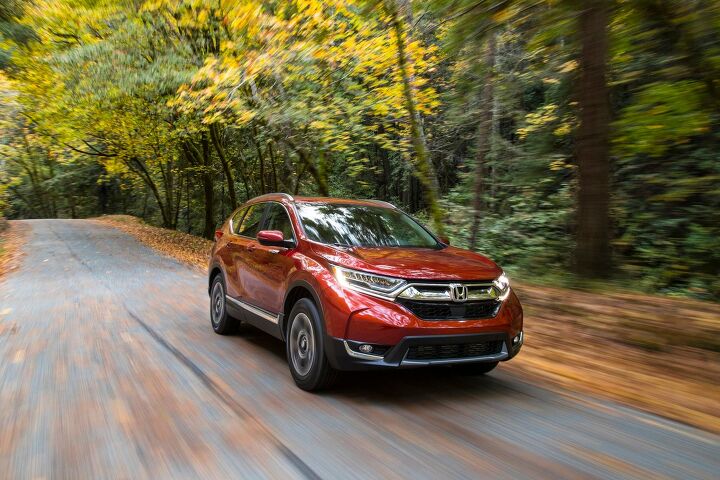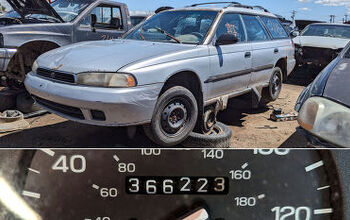Three-Row, Seven-Seat 2018 Honda CR-V Goes on Sale Down Under, but Would Pilot-Driving Americans Want It?
With the launch of the seven-seat Honda CR-V in another ASEAN market, this time Australia, one wonders about the potential popularity of a three-row CR-V in the United States.
The Honda CR-V, America’s top-selling utility vehicle in each of the last five years, currently tops American Honda’s sales charts. The CR-V now accounts for more than one-quarter of Honda’s U.S. sales and generated more volume in the first half of 2017 than in any of the CR-V nameplates’s first 10 calendar years.
Broadening the already popular CR-V’s appeal sounds, at first glance, like an entirely reasonable plan.
Yet there are arguments to be made on both sides.
On the one hand, compact three-row crossovers (Nissan Rogue, Mitsubishi Outlander) aren’t particularly capable seven-seaters, and they lack real cargo-carrying prowess. According to Honda Australia’s specs, there is only 5.3 cubic feet of storage space behind the third row of the 2018 Honda CR-V, less than one-third of what the Honda Pilot manages, less than half what you’d find in a Honda Civic Coupe’s trunk.
The Pilot’s mere existence is another antidote against the U.S. sale of three-row CR-Vs, as well. Despite reporting significantly less volume than the CR-V, the Pilot is a high-volume, high-margin vehicle for American Honda. In Australia, for example, the only other three-row vehicle in Honda’s lineup besides the new three-row CR-V is an Odyssey van that’s not as large as North America’s Alabama-built Odyssey.
Then there’s the issue of the three-row variant actually doing enough for the three-row CR-V to truly broaden its appeal. Honda Australia makes the third row available on just one of four trim levels (the second from the top). Many customers who have no need of the third row don’t want to lose the cargo capacity that disappears, in comparison with a two-row CR-V, when the third row is folded for a flat load floor. Nor do they want to pay for a cramped third row of seats they never plan to use.
Moreover, does Honda even need the CR-V, which has set U.S. sales records in each of the last five years, to broaden its appeal?
Honda has such a high degree of built-in loyalty with the CR-V, however, that it’s possible CR-V owners who are moving on up — not necessarily as buyers who need a third row but as buyers who could periodically make use of it — would remain in the CR-V family.
There’s evidence that supports such an outcome and evidence that suggests otherwise. The Nissan Rogue, which with help of late from the Rogue Sport is presently America’s top-selling utility vehicle, generates roughly 7 percent of its volume with a seven-seat variant. Without that 7 percent, the Rogue would not currently be America’s top-selling non-pickup truck. After the relatively unpopular first-generation Volkswagen Tiguan accomplished little in the U.S. market, Volkswagen will add a third row to most Tiguans as standard equipment for the 2018 model year. Yet the Toyota RAV4 eliminated its third row (and V6 engine) for its current iteration and sales only increased.
There’s also been plenty of discussion about a vehicle to slot in between the CR-V and Pilot. Perhaps that vehicle doesn’t need to be an all-new product but rather a simple seven-seat edition of the CR-V.
American Honda, meanwhile, has predictably little to say on the subject. “We can’t make comments about any future possibilities,” a Honda spokesperson told TTAC via email this morning.
[Images: Honda]
Timothy Cain is a contributing analyst at The Truth About Cars and Autofocus.ca and the founder and former editor of GoodCarBadCar.net. Follow on Twitter @timcaincars.
More by Timothy Cain
Latest Car Reviews
Read moreLatest Product Reviews
Read moreRecent Comments
- Kwik_Shift_Pro4X As much problems as I had with my '96 Chevy Impala SS.....I would love to try one again. I've seen a Dark Cherry Metallic one today and it looked great.
- Susan O’Neil There is a good reason to keep the Chevrolet Malibu and other 4 door family sedans! You can transport your parents and other somewhat handicapped people comfortably and safety! If someone can stand and pivot you can put them in your car. An armrest in the back seat is appreciated and a handle above the door! Oh…and leather seats so your passenger can slide across the seat! 😊Plus, you can place a full sized wheelchair or walker in the trunk! The car sits a little lower…so it’s doable! I currently have a Ford Fusion and we have a Honda Accord. Our previous cars were Mercury Sables-excellent for transporting handicapped people and equipment! As the population ages-sedans are a very practical choice! POV from a retired handicapped advocate and daughter! 😊
- Freddie Remember those ads that say "Call your doctor if you still have...after four hours"?You don't need to call your doctor, just get behind the wheel of a CUV. In fact, just look at one.I'm a car guy with finite resources; I can't afford a practical car during the week plus a fun car on the weekend. My solution is my Honda Civic Si 4 door sedan. Maybe yours is a Dodge Charger (a lot of new Chargers are still on dealer lots).
- Daniel J Interesting in that we have several weeks where the temperature stays below 45 but all weather tires can't be found in a shop anywhere. I guess all seasons are "good enough".
- Steve Biro For all the talk about sedans vs CUVs and SUVs, I simply can’t bring myself to buy any modern vehicle. And I know it’s only going to get worse.



































Comments
Join the conversation
There's more 3-row vehicles available now than ever, yet, where are the big families? Nada, don't exist anymore. Why do people think they need a school bus to drive 1-2 kids around?
I wish Honda Australia would sell the Pilot down here. It would probably make a nice competitor to the Kluger (Highlander to you guys), Pathfinder and the CX-9...